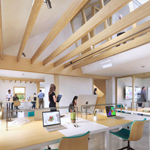
CAMBRIDGE, Mass., May 24, 2017 /PRNewswire/ — The Harvard Center for Green Buildings and Cities at the Harvard University Graduate School of Design (GSD) announced today that it is retrofitting its headquarters in a pre-1940s stick-built house to demonstrate how to transform this challenging building stock into a prototype of ultra-efficiency that will use no HVAC system, no electric light use during the day, 100% ventilation, almost zero energy, and produce zero carbon emissions, including embodied energy of materials.
“Before now, this level of efficiency could only be achieved in new construction,” said Ali Malkawi, professor of architectural technology at the GSD, founding director of the Harvard Center for Green Buildings and Cities and the creator of the HouseZero project. “We want to demonstrate what’s possible, show how this can be replicated almost anywhere, and solve one of the world’s biggest energy problems — inefficient existing buildings.”
The U.S. building stock is responsible for around 40 percent of energy consumption, with housing nearly a quarter of that use. Property owners spend more than $230 billion annually heating, cooling and powering its 113.6 million homes. HouseZero could help curb climate change by creating a blueprint for reducing the demand for energy, as well as saving money for property owners by lowering operating costs.
Mohsen Mostafavi, Dean of Harvard GSD and the Alexander and Victoria Wiley Professor of Design, said, “The HouseZero project represents precisely the kind of transformative impact through design that we strive to make at the GSD. With this test case – retrofitting a house in Cambridge into a new work space – the Center for Green Buildings and Cities directly engages the ways in which we can reimagine the future of many of our cities and their utilization of resources.”
The HVAC system will be replaced with thermal mass, and a ground source heat pump for peak (extreme) conditions. A solar vent will instigate buoyancy-driven ventilation and triple-glazed windows will employ natural cross ventilation through a manual and automated system that monitors for temperature, humidity and air quality.
HouseZero’s interior will model a healthy environment with natural light, no off-gassing material and is designed to be comfortable, durable, functional, and flexible, with great acoustics. The space will also promote well-being and productivity. Rather than approaching the house as a “sealed box,” the building envelope and materials of HouseZero are designed to interact with the seasons and the exterior environment in a more natural way. Much like a layered approach to clothing, the house is meant to adjust itself seasonally, and even daily, to reach thermal comfort targets.
“All components of the building are sensored to generate data that will allow the building to adjust itself and fuel CGBC research focused on actual data and simulated environments,” said Professor Ali Malkawi. The building will also feature a flexible, highly-controlled and monitored experimental lab that is hardwired to the building’s energy exchange system. Because the lab is connected to an ultra-efficient structure, this space will allow for the testing, swapping, and optimization of new, intelligent technologies, façades, and materials to inspire the next generation of ultra-efficient buildings.
Conceptual design was fueled by the center’s blueprint and developed in collaboration with Snøhetta as the project’s lead architect, interior and landscape architect. The firm was hired because of its Scandinavian roots and its demonstrated commitment to the advancement of energy positive buildings in this region. Skanska Technology (Norway) led the energy concept with significant simulation support from CGBC research teams and Skanska (USA) provided pre-construction input. Project management logistics were provided by Harvard Planning & Project Management (HPPM) and CSL Consulting, and operations support was provided by staff from Harvard GSD. Columbia Construction will manage and execute the construction process.
HouseZero will not promote or seek any special certification because it wants to demonstrate an entirely new paradigm for ultra-efficiency, one that is localized and focused on curbing energy demand, with energy production secondary to that.
Construction will take about 7-9 months.
About Harvard Center for Green Buildings & Cities
The Harvard Center for Green Buildings and Cities (CGBC) aims to transform the building industry through a commitment to design-centric strategy that directly links research outcomes to the development of new processes, systems, and products. By strongly emphasizing innovation and multidisciplinary collaboration, the Center will work to promote holistic change within the built environment, namely the creation and continued improvement of sustainable, high performance buildings and cities. The CGBC was established at the Harvard Graduate School of Design in 2014.
For more information, contact:
Molly Kalan
InkHouse Media + Marketing
[email protected]
781-966-4115
The release is also available here.
